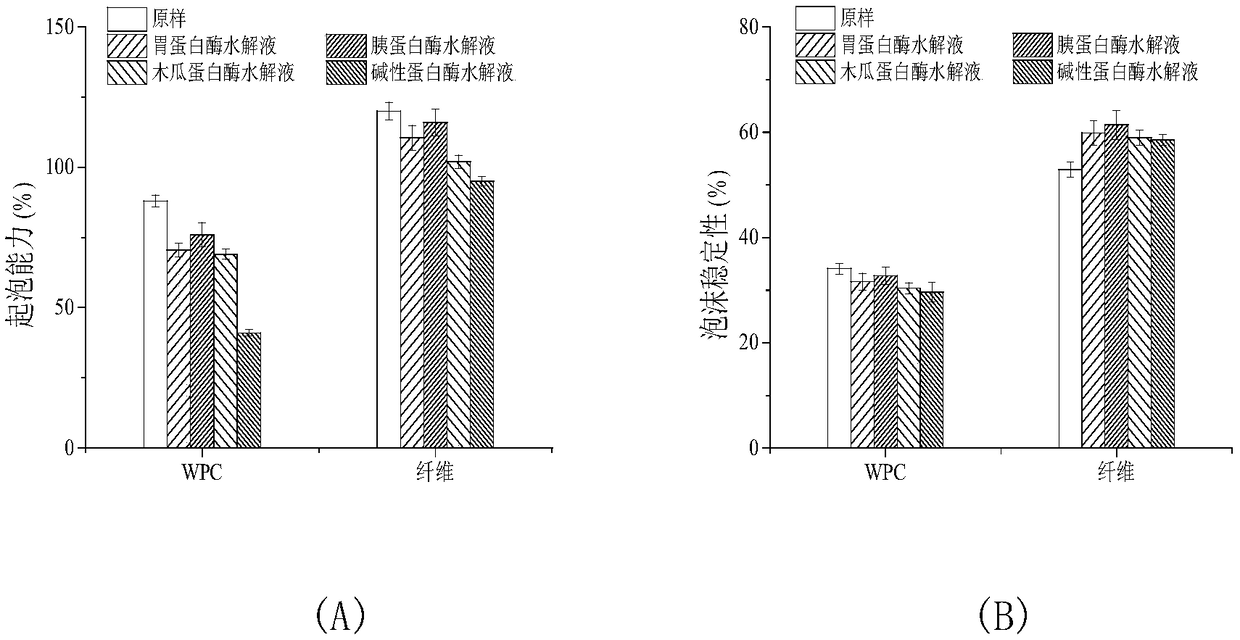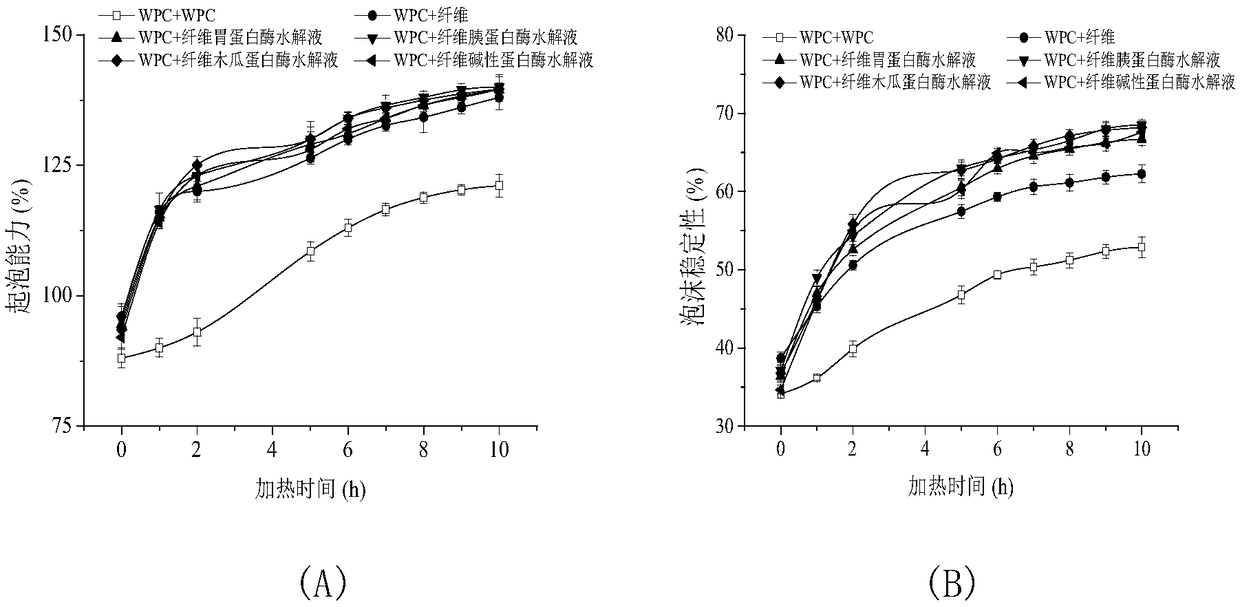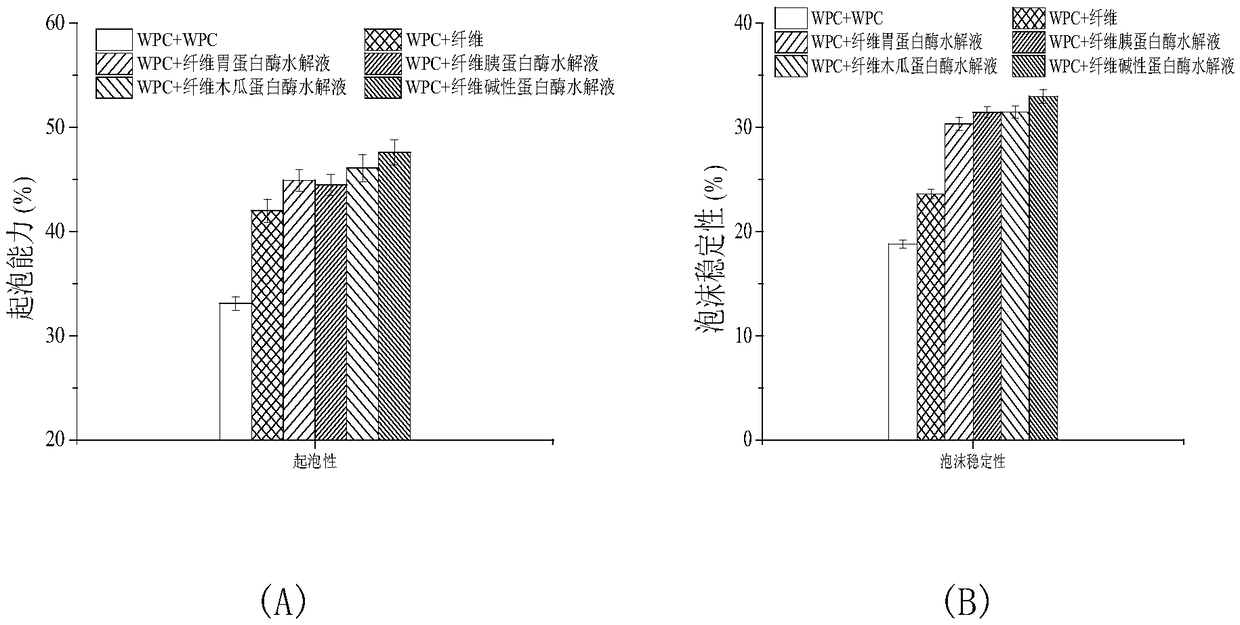Method for improving foaming property and foam stability of protein
A technology of foam stability and protein, which is applied in the field of improving protein foaming and foam stability, improving whey protein concentrate foaming and foam stability, and can solve the problems of protein application limitation and insufficient improvement effect, and achieve The hydrolysis process is simple, easy to promote, and the effect of mild hydrolysis conditions
- Summary
- Abstract
- Description
- Claims
- Application Information
AI Technical Summary
Problems solved by technology
Method used
Image
Examples
Embodiment 1
[0042] Using whey protein concentrate as raw material, take 4.00g whey protein concentrate powder and dissolve it in deionized water, adjust the pH value of the solution to 2.0 and set the volume to 100mL, centrifuge at 16000g for 20min (4°C), take the supernatant with deionized water Dilute the protein solution to 2.0% (w / v), adjust the pH to 2.0 again, heat-treat at 90°C for 10h, take a sample and store it in a refrigerator at 4°C to prepare a nanofiber polymer;
[0043] Take 45mL of 2.0wt% nanofiber polymer, add 6M NaOH to adjust the pH to 7.0, and dilute to 50mL with deionized water (pH 7.0). According to the ratio of enzyme to substrate (E / S) 1 / 30 (7447U / g protein, w / w), add trypsin solution, digest in water bath at 37°C for 2h, and inactivate at 90°C for 20min after enzymolysis to obtain hydrolyzate;
[0044] Use 6M HCl to adjust the pH value of the hydrolyzed solution to 2.0 and dilute the protein concentration of the hydrolyzed solution to 1.5 wt% with deionized water ...
Embodiment 2
[0046] Using whey protein concentrate as raw material, take 4.00g whey protein concentrate powder and dissolve it in deionized water, adjust the pH value of the solution to 2.0 and set the volume to 100mL, centrifuge at 16000g for 20min (4°C), take the supernatant with deionized water Dilute the protein solution to 2.0% (w / v), adjust the pH to 2.0 again, heat-treat at 90°C for 10h, take a sample and store it in a refrigerator at 4°C to prepare a nanofiber polymer;
[0047] Take 45mL of 2.0wt% nanofiber polymer, add 6M NaOH to adjust the pH to 7.0, and dilute to 50mL with deionized water (pH 7.0). Add trypsin solution according to the ratio of enzyme to substrate (E / S) 1 / 30 (7447U / g protein, w / w), digest in 37°C water bath for 2h, and inactivate at 90°C for 20min after enzymolysis to obtain hydrolyzate.
[0048] Use 6M HCl to adjust the pH value of the hydrolyzed solution to 2.0 and dilute the protein concentration of the hydrolyzed solution to 1.5 wt% with deionized water (pH ...
Embodiment 3
[0050] Using whey protein concentrate as raw material, take 4.00g whey protein concentrate powder and dissolve it in deionized water, adjust the pH value of the solution to 2.0 and set the volume to 100mL, centrifuge at 16000g for 20min (4°C), take the supernatant with deionized water Dilute the protein solution to 2.0% (w / v), adjust the pH to 2.0 again, heat-treat at 90°C for 10h, take a sample and store it in a refrigerator at 4°C to prepare a nanofiber polymer.
[0051] Take 45mL of 2.0wt% nanofiber polymer, add 6M NaOH to adjust the pH to 7.0, and dilute to 50mL with deionized water (pH 7.0). Add trypsin solution according to the ratio of enzyme to substrate (E / S) 1 / 30 (7447U / g protein, w / w), digest in 37°C water bath for 2h, and inactivate at 90°C for 20min after enzymolysis to obtain hydrolyzate.
[0052] Use 6M HCl to adjust the pH value of the hydrolyzed solution to 2.0 and dilute the protein concentration of the hydrolyzed solution to 1.5 wt% with deionized water (pH ...
PUM
 Login to View More
Login to View More Abstract
Description
Claims
Application Information
 Login to View More
Login to View More - R&D
- Intellectual Property
- Life Sciences
- Materials
- Tech Scout
- Unparalleled Data Quality
- Higher Quality Content
- 60% Fewer Hallucinations
Browse by: Latest US Patents, China's latest patents, Technical Efficacy Thesaurus, Application Domain, Technology Topic, Popular Technical Reports.
© 2025 PatSnap. All rights reserved.Legal|Privacy policy|Modern Slavery Act Transparency Statement|Sitemap|About US| Contact US: help@patsnap.com



